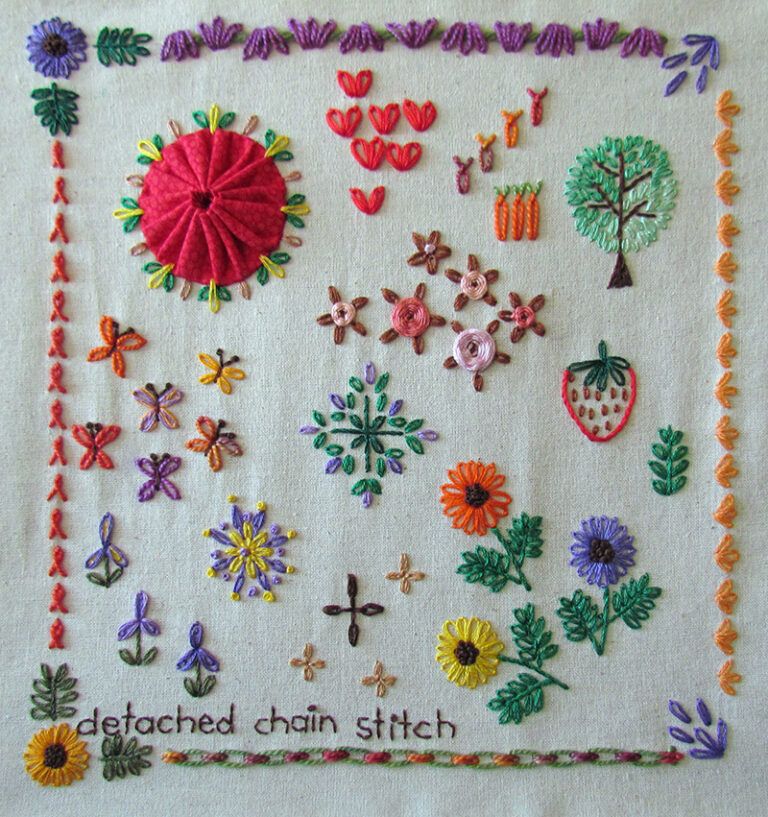Detached Chain Stitch
Do you want to add a unique touch to your embroidery? Are you tired of the same old stitching techniques? Look no further than the detached chain stitch!
Many embroiderers struggle with finding new ways to make their work stand out. They may feel like they've hit a creative wall and don't know how to break free from the same old stitching methods. This is where detached chain stitch can come in handy.
The detached chain stitch, also known as the lazy daisy stitch, is a fun and simple embroidery stitch that can add texture and dimension to your work. It is easy to learn and perfect for beginners, making it a great way to add interest to your work without feeling overwhelmed.
In essence, the detached chain stitch is a series of individual chain stitches that are not connected to each other. Instead, they are stitched onto the surface of the fabric, creating a looped effect that resembles a daisy petal. This stitch can be used to create flowers, leaves, and other decorative elements in your designs.
My personal experience with detached chain stitch
I first discovered the detached chain stitch when I was looking for a way to add some variety to my embroidery. I was tired of the same old satin stitches and French knots and wanted to try something different.
After watching a few online tutorials, I quickly fell in love with the detached chain stitch. It was so simple yet so versatile, allowing me to create a wide variety of designs with ease. I especially loved using it to create the petals of flowers, adding a delicate touch to my work.
As I became more comfortable with the stitch, I started experimenting with different thread weights and textures. I found that using a thicker thread created a bolder, more pronounced look, while using a thinner thread resulted in a more delicate, ethereal effect.
Using detached chain stitch in your designs
If you're interested in incorporating the detached chain stitch into your embroidery designs, there are a few things to keep in mind. First, make sure you are comfortable with the basic chain stitch, as the detached chain stitch is essentially just a single chain stitch with a loop added at the end.
Once you've mastered the basic stitch, experiment with different thread weights and textures to see what effect you prefer. You can also combine the detached chain stitch with other stitches, such as the French knot or satin stitch, to create more complex designs.
Tips for perfecting your detached chain stitch
Here are a few tips to keep in mind as you practice your detached chain stitch:
- Use a hoop or frame to keep your fabric taut and prevent puckering.
- Make sure your stitches are evenly spaced and the loops are consistent in size.
- Try stitching the loops in different directions to create a more natural-looking design.
- Experiment with different colors and thread types to create unique effects.
Common mistakes to avoid
As with any embroidery stitch, there are a few common mistakes to watch out for when practicing the detached chain stitch. These include:
- Not spacing your stitches evenly, resulting in a lopsided or messy design.
- Not keeping your thread tension consistent, which can cause wrinkles or puckering in your fabric.
- Using a thread that is too thick or too thin for your design, resulting in a lack of detail or an overwhelming effect.
Question and Answer
Q: Can the detached chain stitch be used for more than just flowers?
A: Absolutely! While the detached chain stitch is often used to create flowers, it can be used to create a wide variety of designs. Try experimenting with different stitch directions and thread textures to see what you can come up with.
Q: Is the detached chain stitch difficult to learn?
A: Not at all! In fact, the detached chain stitch is considered one of the easiest embroidery stitches to learn. With a little practice, you'll be creating beautiful designs in no time.
Q: What types of thread are best for the detached chain stitch?
A: The great thing about the detached chain stitch is that it can be used with a wide variety of thread types, including cotton, silk, and wool. Experiment with different thread weights and textures to see what works best for your design.
Q: Can the detached chain stitch be used on different types of fabric?
A: Yes! The detached chain stitch can be used on a variety of fabrics, including cotton, linen, wool, and silk. However, keep in mind that the fabric you choose may affect the final look of your design, so experiment with different fabrics to see what effect you prefer.
Conclusion
The detached chain stitch is a versatile and fun embroidery stitch that can add a unique touch to your designs. With a little practice and experimentation, you'll be able to create beautiful flowers, leaves, and other decorative elements with ease. So why not give it a try and see where your creativity takes you?
Gallery
Textile Explorations: The Stitch Files - Detached Chain Stitch

Photo Credit by: bing.com / explorations
Textile Explorations: The Stitch Files - Detached Chain Stitch

Photo Credit by: bing.com / chain detached stitch examples stitches explorations textile quilting crazy used some sf
Detached Chain Stitch Sampler For TAST, Week 7. » Knitting-and.com

Photo Credit by: bing.com / sampler stitches tast knitting flashback weeks
Textile Explorations: TAST 2012 - Detached Chain Stitch

Photo Credit by: bing.com / chain stitch detached tast playing around
Arnold's Attic: Hand Embroidery Samples 2.. Detached Chain Stitch

Photo Credit by: bing.com / embroidery hand samples stitch detached chain attic arnolds thread
